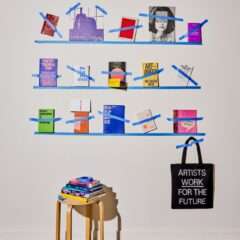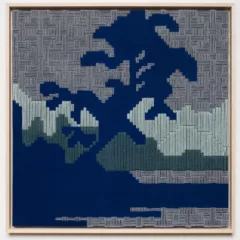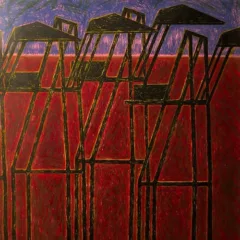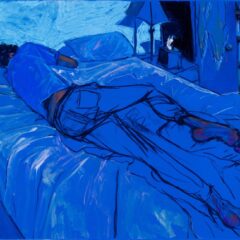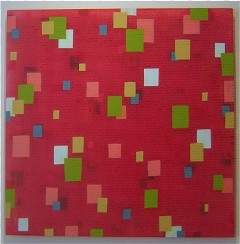
Steven Baris’ The Correct Distance #B5, 30 x 30 inches
Jellybeans is what I think of whenever I see a Steven Baris painting. It has to do with the translucent glow and the Pop colors. Baris’ one-man show of 19 works at Pentimenti until May 27, looks great.
Baris’ translucency is achieved by painting with acrylic on Plexiglas. He also finishes his painting with a kind of waxy material. The resulting surface has a matte glow. All of these add up to a sense of layers in space, of depth.
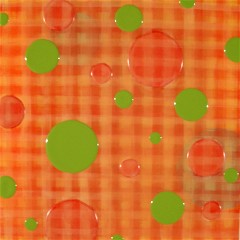
Baris’ Spread #A9, 14 x 14 inches
Some pieces have poured dots punctuating a plaid background. This series of work is downright comical. Maybe it’s because of the scale of the dots (or the suggestion of fizzy soda bubbles) which have a clown-costume scale vis a vis the plaids. The larger–or supposedly closer ones–also are the right size for bouncing balls. The shiny, industrial thickness of the pools of paint contrasts with the thin plaid, which sometimes is beneath, sometimes covering the dots.

Landscape with Random Clusters #35, 14 x 14 inches
These spatial issues prevail in all of Baris’ paintings, where abstract blips and blurs and backgrounds suggest place and space and yet are all on the painting surface. They are visual space stations, defining what’s near and far, and yet undermining what’s near and far. They do this with such bouncy charm and such look-at-me exuberance that the monolog about depth seems easy to follow, more of a game than a philosophical disquisition.
In a way it reflects cyberspace, a non-place kind of landscape in which there is no space at all, with glowing colors that contradict the absence of material.
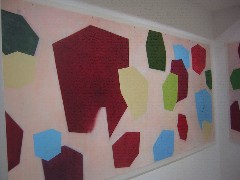
Baris’s Compartmental #D7, 48 x 103 inches, oil on mylar
Baris also created three large paintings for Pentimenti’s tiny Project Space. The works have a more casual application of paint and finish, but the floating cubes in pastel skies raise the same issues of space as they attempt to push the walls of the gallery space back. Because the work is on sheets of mylar, I missed that happy melding of subject and the thick solidity of the Plexiglas substrate. The colors aim to make up a piece of that difference by suggesting deep space at close range.
Also at Pentimenti
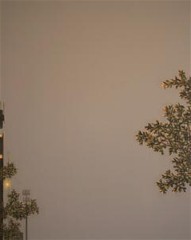
Janaki Lennie’s Breathing Space #61
Also at Pentimenti in the annex gallery are three other artists. Janaki Lennie’s Breathing Space series focuses on the glow of dirt-colored skies. The skies bracketed on both sides by bits of the landscape have a pulsing visual tension that falls apart without the pair of space markers–either bits of trees or industrial towers. The works are an unexpected mix of Zen sky meditations and eco disaster commentary all at once.
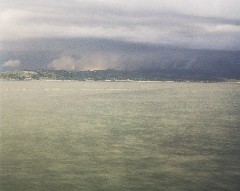
Justyna Badach’s Untitled Seascape #2 (After Monet)
Local artist Justyna Badach is showing two enormous, digitally altered photographs of where the sea meets the shore. In these photos, Badach removes things to create romanticized views, taken from an unlikely, mid-sea perspective. To me they seem to be photos of emptiness. They are the antithesis of the picturesque painting tradition in which nature and bits of human occupation–a crumbling castle, or perhaps an ancient bridge–give the paintings of nature some kind of focus that nature alone lacks. To deliberately counter this by removing all traces of focus is an interesting thought. The fogginess and the digital inkjet print-out (which falls apart on this large scale of 44 x 54 1/2 inches) all appropriately magnify this, but I found myself yearning for more to look at–or more to think about.
Also showing at Pentimenti are a few of Mary Bennett’s altered books (see previous post here for more on her work).


